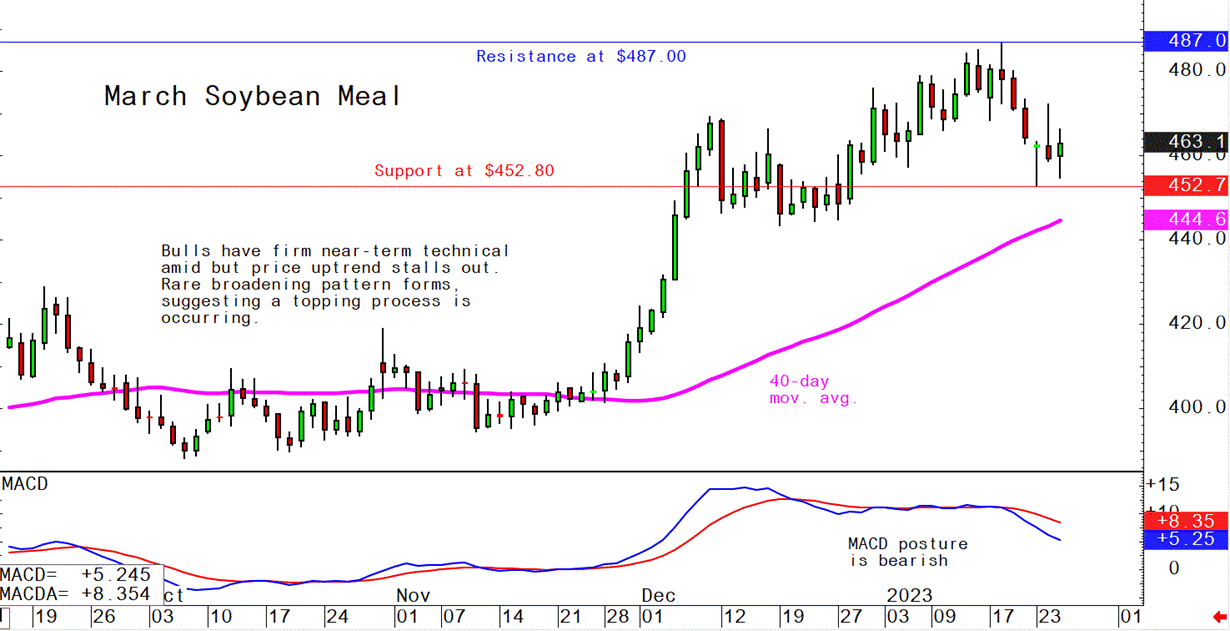



Pig outlook: Lean hog futures bulls hoping for seasonal bottom
Analyst Jim Wyckoff shares an update on the US futures market, USDA reports and global pig newsCME lean hog futures
Lean hog futures prices this week scored a 3.5-month low and remain in a steep downtrend on the daily bar chart. Bears are in technical control. The latest CME lean hog index is down 2 cents to $72.11 (as of Jan. 23) Until the cash index signals a bottom, upside in futures will be limited.
USDA Cold Storage Report
USDA’s Cold Storage Report was released Wednesday afternoon. The five-year average is a 3.2 million-lb. decline in pork stocks during the month.
The Cold Storage Report showed total frozen poultry supplies on December 31, 2022 were up 7 percent from the previous month and up 23 percent from a year ago. Total stocks of chicken were up 2 percent from the previous month and up 25 percent from last year. Total pounds of turkey in freezers were up 35 percent from last month and up 14 percent from December 31, 2021.
Total red meat supplies in freezers were up 2 percent from the previous month and up 11 percent from last year. Total pounds of beef in freezers were up 4 percent from the previous month and up 7 percent from last year. Frozen pork supplies were up 1 percent from the previous month and up 16 percent from last year. Stocks of pork bellies were up 16 percent from last month and up 66 percent from last year.
Latest USDA and other news regarding the global pork industry
The US large hog slaughter levels are raising concerns about the hog population reduction reported in the December USDA Hogs & Pigs report. That report implied hog numbers and slaughter levels would average 2% under year-ago levels through the first half of this year. However, after topping the year-ago figure by 13% in the first full work week of the year, last week’s total represented a 3.9% annual increase. This week’s early kills have also exceeded year-ago levels, with the Monday-Tuesday sum topping last year by 5.4%.
Bacon drives growth in UK pig meat trade - AHDB
Imports of pork into the UK totalled 70,200 tonnes during November, a month on month increase of 2,600 tonnes (3.8%), and year on year increase of 922 tonnes (1.3%), according to a report from AHDB analyst Charlotte Forkes-Rees. Overall shipments from the EU were up in November, with Denmark trading the largest volume at 17,200 tonnes, up 14.8% (2,200 tonnes) compared to the previous month. Poland saw the greatest reduction in volumes shipped to the UK month on month, easing 1,000 tonnes (17.0%). Volumes of fresh/ frozen pork were unchanged on the month, with 27,900 tonnes imported in November, however volumes eased 12.2% on the same month last year. Bacon and sausage imports continued to record growth both on the month and on the year. Sausages saw the greatest uplift on the year in volume terms with an increase of 3,900 tonnes (39%), while bacon increased by 938 tonnes (5.5%). In the year to date (Jan – Nov), 737,900 tonnes of pork has been imported, an increase of 74,400 tonnes (11.2%) on the same period in 2021. Imports for all categories of pork saw growth, however bacon and sausages saw the greatest uplift, up 22.2% and 24.5% respectively.
Exports of pork from the UK totalled 28,800 tonnes, a 1.2% (353 tonnes) uplift on October, however back by 8.3% (2,600 tonnes) on November 2021. The EU accounted for 45.2% (13,000 tonnes) of exports, slightly ahead of October and holding in line with the average for the year. Within the EU, the largest volumes were exported to France which received 2,300 tonnes of pig meat, the majority as fresh/frozen pork (1,555 tonnes). Outside of the EU-27, 11,100 tonnes of pig meat was exported to China which accounted for 38.4% of November’s trade. More than 7,000 tonnes of offal was exported to China, which indicates how important trade relationships with both the EU and China are for maintaining carcase balance.
Ukraine's wheat, corn crops seen shrinking again as farmers struggle
Ukraine's corn and wheat production is set to fall for a second year in 2023, with corn output not expected to exceed 18 million tonnes and wheat production 16 million tonnes as farmers reduce planting due to the war, Reuters reported, citing a grain sector group on Thursday. The projections were a best case scenario, and production could fall more sharply depending on weather and financial difficulties of farms, Ukraine Grain Association (UGA) head Nikolay Gorbachov told Reuters on the sidelines of Argus Media's Paris Grain Conference. Disruption to export trade following Russia's invasion last year has left many farmers producing at a loss, he said. Overall, Ukraine's grain and oilseed crop output may decline to around 50 million tonnes from some 67 million in 2022 and about 106 million in 2021, according to UGA estimates.
Ukraine has managed to export around 30 million tonnes of grains and oilseeds so far in the 2022/23 season using a Black Sea grain corridor negotiated with Russia, as well as alternative routes via European Union countries, he said. But backlogs in the Black Sea corridor and less efficient logistics in alternative routes were creating high costs that hit farmgate prices, he said, blaming Russia for slowing vessel inspections in the corridor. Corn has been particularly affected by financial constraints as it is relatively expensive to grow, dry and transport, he said, adding about 10% of the 2022 crop remained unharvested as farmers wait for some fields to dry out.
The next week’s likely high-low price trading ranges:
April lean hog futures--$82.625 to $88.00 and with a sideways-lower bias
March soybean meal futures--$450.00 to $475.00, and with a sideways bias
March corn futures--$6.61 1/4 to $6.90 and a sideways-higher bias
Latest analytical daily charts lean hog, soybean meal and corn futures












